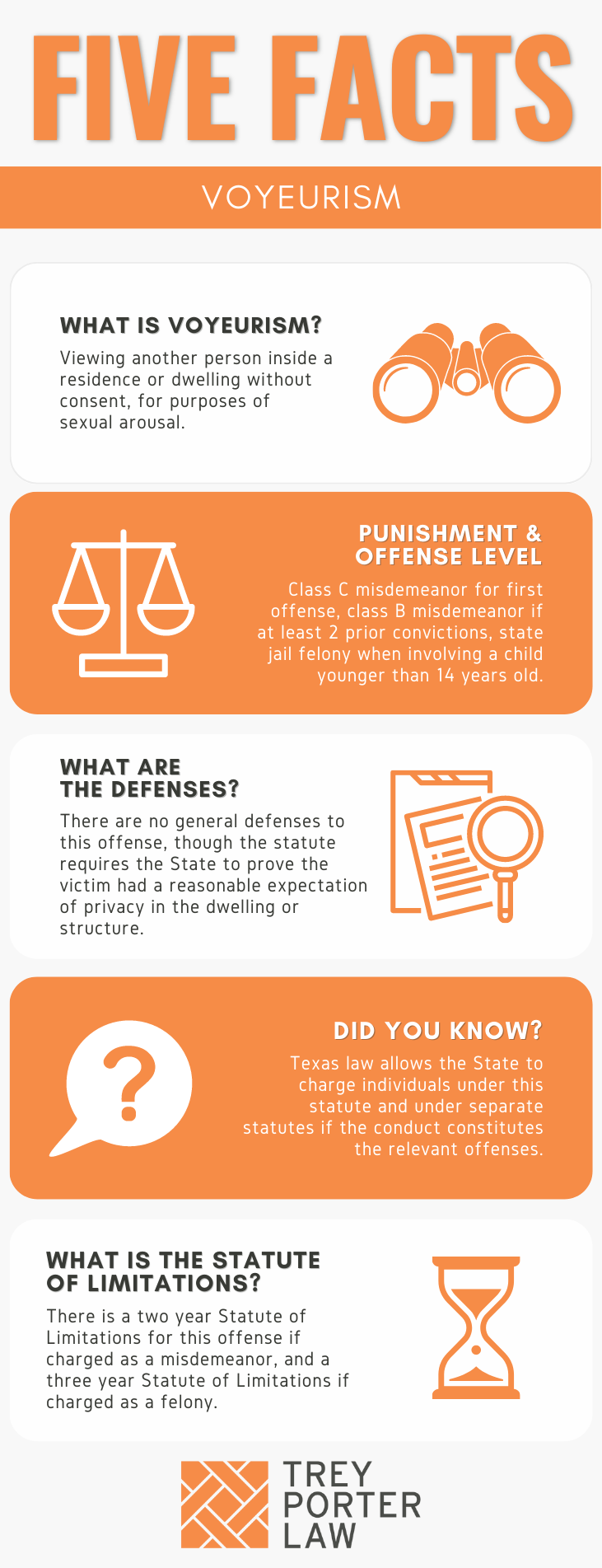WHAT IS VOYEURISM IN TEXAS?
Voyeurism is surreptitiously peering into another’s home or other structure without permission for sexual arousal or gratification.

WHAT IS THE VOYEURISM LAW IN TEXAS?
Tex. Penal Code § 21.17. VOYEURISM.
(a) A person commits an offense if the person, with the intent to arouse or gratify the sexual desire of the actor, observes another person without the other person’s consent while the other person is in a dwelling or structure in which the other person has a reasonable expectation of privacy.
(b) Except as provided by Subsection (c) or (d), an offense under this section is a Class C misdemeanor.
(c) An offense under this section is a Class B misdemeanor if it is shown on the trial of the offense that the actor has previously been convicted two or more times of an offense under this section.
(d) An offense under this section is a state jail felony if the victim was a child younger than 14 years of age at the time of the offense.
(e) If conduct that constitutes an offense under this section also constitutes an offense under any other law, the actor may be prosecuted under this section, the other law, or both.
WHAT IS THE PENALTY CLASS FOR VOYEURISM IN TEXAS?
Voyeurism is a Class C misdemeanor, punishable by a fine of $500. Voyeurism may be enhanced to a Class B misdemeanor, which is punishable by up to 180 days in county jail, if a person has been convicted at least twice of voyeurism previously, or the victim was a child under 14.
WHAT IS THE PUNISHMENT RANGE FOR VOYEURISM IN TEXAS?
Voyeurism charged as a Class B misdemeanor carries up to 180 days in jail, and a maximum fine of $2,000. If voyeurism is a first offense charged as a Class C misdemeanor, it is punishable by a fine of $500, and no jail time.
WHAT ARE THE PENALTIES FOR VOYEURISM IN TEXAS?
As an alternative to jail time, a person convicted of Class C misdemeanor voyeurism may only be punished with a maximum fine of $500. To avoid a conviction, a person charged with Class C misdemeanor voyeurism may receive a deferred disposition for up to 180 days. If charged with Class B misdemeanor voyeurism, a person may be placed on probation after a conviction, or deferred adjudication without a conviction, for a period not to exceed two years.
WHAT ARE THE DEFENSES TO VOYEURISM IN TEXAS?
A person accused of voyeurism may argue he or she was not watching others in their private spaces with the intent to arouse or gratify his or her sexual desire.
- What is the intent to arouse or gratify the sexual desire of any person? Sex offenses requiring the specific intent to arouse or gratify one’s sexual desire make it clear the actor may intend to commit the offense for his own arousal or sexual gratification, or to arouse or gratify another person. A voyeur’s sexual gratification may be inferred by the voyeur’s actions before, during, and after committing the offense.If, for example, a person masturbated while watching a woman undress in her bedroom, it is logical to conclude the person was watching for his own arousal. But if, on the other hand, a person peered into another’s home to check on the occupant’s welfare, that is not for a sexual purpose.
WHAT IS THE STATUTE OF LIMITATIONS FOR VOYEURISM IN TEXAS?
The limitation period for voyeurism, whether it is charged as a Class C or Class B misdemeanor, is two years.
VOYEURISM IN TEXAS
Peering into another’s home or other private structure without permission for arousal or sexual gratification purposes is against the law in Texas.
















